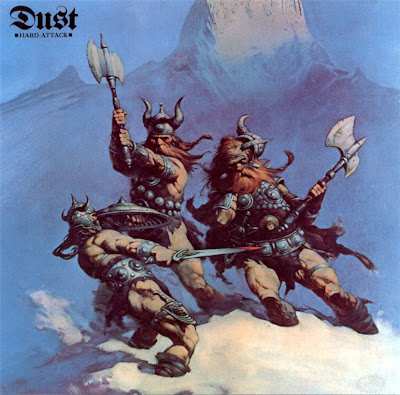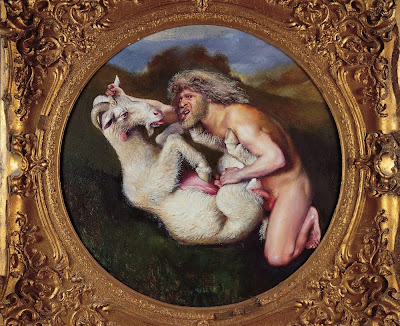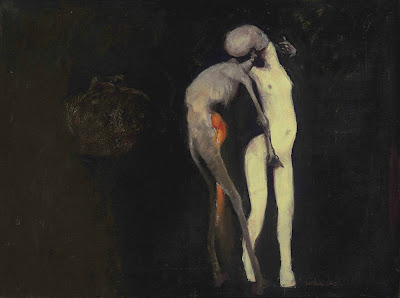Some of their masterpieces, full lenghth albums in each video
Τετάρτη 29 Φεβρουαρίου 2012
Πέμπτη 23 Φεβρουαρίου 2012
Frank Frazetta, epic fantasy

Conan
Frank Frazetta (1928 – 2010) was an American fantasy and science fiction artist, noted for work in comic books, paperback book covers, paintings, posters, LP record album covers and other media. Frazetta was drawing comic books in many genres, including Westerns, fantasy, mystery, and historical drama. He also produced paintings for paperback editions of adventure books. His interpretation of Conan visually redefined the genre of sword and sorcery, and had an enormous influence on succeeding generations of artists. From this point on, Frazetta's work was in great demand. His covers were used for other paperback editions of classic Edgar Rice Burroughs books, such as those from the Tarzan and Barsoom (John Carter of Mars) series. He also did several pen and ink illustrations for many of these books. His cover art only coincidentally matched the storylines inside the books, as Frazetta once explained: "I didn't read any of it... I drew him my way. It was really rugged. And it caught on. I didn't care about what people thought. People who bought the books never complained about it. They probably didn't read them.

Conan

Conan

Dust "Hard Attack" (1972)

Nazareth "Expect no Mercy" (1977)

Molly Hatchet "self titled" (1978)

Molly Hatchet "Flirtin' with Disaster" (1979)

Molly Hatchet "Beatin' the Odds" (1980)
Ετικέτες
art classic-medieval,
Frank Frazetta
Σάββατο 18 Φεβρουαρίου 2012
Τρίτη 14 Φεβρουαρίου 2012
Robert Oscar Lenkiewicz

Dead Mother
Robert Oscar Lenkiewicz (1941 – 2002) was one of England's most celebrated artists of modern times. Perennially unfashionable in high art circles, his work was nevertheless popular with the public.
 He painted on a large scale, usually in themed Projects investigating hidden communities (Vagrancy 1973, Mental Handicap 1976) or difficult social issues (Suicide 1980, Death 1982). Inspired by the example of Albert Schweitzer, Lenkiewicz threw open the doors of his studios to anyone in need of a roof – down and outs, addicts, criminals and the mentally ill congregated there. These individuals were the subjects of his paintings as a young man. However, such colourful characters were not welcomed by his neighbours and he was obliged to leave London in 1964. He spent a year living in a remote cottage in Cornwall, supporting his young family by teaching, before being offered studio space on the Barbican in Plymouth. The artist's home and studios once more became a magnet for vagrants and street alcoholics, who then sat for paintings. Their numbers swelled and Lenkiewicz was forced to commandeer derelict warehouses in the city to house the 'dossers'. One of these warehouses also served as a studio and in 1973 became the exhibition space for the Vagrancy Project.
He painted on a large scale, usually in themed Projects investigating hidden communities (Vagrancy 1973, Mental Handicap 1976) or difficult social issues (Suicide 1980, Death 1982). Inspired by the example of Albert Schweitzer, Lenkiewicz threw open the doors of his studios to anyone in need of a roof – down and outs, addicts, criminals and the mentally ill congregated there. These individuals were the subjects of his paintings as a young man. However, such colourful characters were not welcomed by his neighbours and he was obliged to leave London in 1964. He spent a year living in a remote cottage in Cornwall, supporting his young family by teaching, before being offered studio space on the Barbican in Plymouth. The artist's home and studios once more became a magnet for vagrants and street alcoholics, who then sat for paintings. Their numbers swelled and Lenkiewicz was forced to commandeer derelict warehouses in the city to house the 'dossers'. One of these warehouses also served as a studio and in 1973 became the exhibition space for the Vagrancy Project. He first came to public attention when the media highlighted his giant mural man on Plymouth's Barbican in the 1970s. Another furore occurred in 1981 when he faked his own death in preparation for the forthcoming project of paintings on the theme of death (1982): "I could not know what it was like to be dead," said the artist, "but I could discover what it was like to be thought dead."
He first came to public attention when the media highlighted his giant mural man on Plymouth's Barbican in the 1970s. Another furore occurred in 1981 when he faked his own death in preparation for the forthcoming project of paintings on the theme of death (1982): "I could not know what it was like to be dead," said the artist, "but I could discover what it was like to be thought dead." Lenkiewicz, aged 60, died of a heart attack in 2002. Despite painting 10,000 works rated of 'national importance' by the British Museum he had only £12 cash in his possession (having never opened a bank account), and owed £2 million to various creditors. Since his death examples of his best paintings have fetched ever-rising prices in London auction rooms. In his obituary of Lenkiewicz, art critic David Lee observed: "Robert's greatest gift was to show us that an artist could be genuinely concerned about social and domestic issues and attempt the difficult task of expressing this conscience through the deeply unfashionable medium of figurative painting. In that sense he was one of few serious painters of contemporary history."
Lenkiewicz, aged 60, died of a heart attack in 2002. Despite painting 10,000 works rated of 'national importance' by the British Museum he had only £12 cash in his possession (having never opened a bank account), and owed £2 million to various creditors. Since his death examples of his best paintings have fetched ever-rising prices in London auction rooms. In his obituary of Lenkiewicz, art critic David Lee observed: "Robert's greatest gift was to show us that an artist could be genuinely concerned about social and domestic issues and attempt the difficult task of expressing this conscience through the deeply unfashionable medium of figurative painting. In that sense he was one of few serious painters of contemporary history." Lenkiewicz investigated some of society's most persistent taboos in Projects such as Vagrancy, Mental Handicap, Jealousy, Orgasm, Suicide and Sexual Behaviour. Here, Lenkiewicz often adopted an allegorical pictorial style to portray human physiology in extremis. Lenkiewicz came to the conclusion that the kinds of sensations people felt when a lover abandoned them or when their cherished beliefs were threatened were identical in kind to the 'withdrawal symptoms' and anxieties experienced by addicts or alcoholics over their preferred narcotic. These Projects thus became an extended study in 'addictive behaviour'.
Lenkiewicz investigated some of society's most persistent taboos in Projects such as Vagrancy, Mental Handicap, Jealousy, Orgasm, Suicide and Sexual Behaviour. Here, Lenkiewicz often adopted an allegorical pictorial style to portray human physiology in extremis. Lenkiewicz came to the conclusion that the kinds of sensations people felt when a lover abandoned them or when their cherished beliefs were threatened were identical in kind to the 'withdrawal symptoms' and anxieties experienced by addicts or alcoholics over their preferred narcotic. These Projects thus became an extended study in 'addictive behaviour'. The conclusions drawn from his own observations were supported by his private library, which he viewed as a history of 'fanatical belief systems'. Lenkiewicz contended that in the absence of any good reasons for our beliefs or emotions we must always look to human physiology for an explanation of fanatical or obsessive behaviour and that it is there that we shall discover the roots of fascism – the tendency to treat another person as property. Lenkiewicz saw all his Projects (21 in all) as part of a large-scale investigation into the origins of fascism - the tendency to treat other people as property - and the roots of obsessive and fanatical behaviour.
The conclusions drawn from his own observations were supported by his private library, which he viewed as a history of 'fanatical belief systems'. Lenkiewicz contended that in the absence of any good reasons for our beliefs or emotions we must always look to human physiology for an explanation of fanatical or obsessive behaviour and that it is there that we shall discover the roots of fascism – the tendency to treat another person as property. Lenkiewicz saw all his Projects (21 in all) as part of a large-scale investigation into the origins of fascism - the tendency to treat other people as property - and the roots of obsessive and fanatical behaviour. On and off, for nearly 30 years, he worked on his great masterpiece, the Riddle Mural in the Round Room at Port Eliot house, home of the Earl of St. Germans, but died before its completion. Half of the mural, in the 40-foot-diameter (12 m) room, shows death, destruction, insanity, unrequited love, and the apocalyptic end of the world. The other half reflects love and affection, friendships, harmony, proportion and consensus. Hidden in the work are various references to family skeletons, art history and cabalistic mysteries, hence the name - the Riddle Mural.
On and off, for nearly 30 years, he worked on his great masterpiece, the Riddle Mural in the Round Room at Port Eliot house, home of the Earl of St. Germans, but died before its completion. Half of the mural, in the 40-foot-diameter (12 m) room, shows death, destruction, insanity, unrequited love, and the apocalyptic end of the world. The other half reflects love and affection, friendships, harmony, proportion and consensus. Hidden in the work are various references to family skeletons, art history and cabalistic mysteries, hence the name - the Riddle Mural.Diogenes
Ετικέτες
art modern,
Robert Oscar Lenkiewicz
Παρασκευή 10 Φεβρουαρίου 2012
Bernie Wrightson
 Bernie Wrightson (1948-) is an American artist known for his horror illustrations and comic books. His first professional comic work was the story "The Man Who Murdered Himself" which appeared in House of Mystery #179 (March-April 1969). He continued to work on a variety of mystery and anthology titles for both DC and its principal rival, Marvel Comics. With writer Len Wein, Wrightson co-created the muck creature Swamp Thing in House of Secrets #92 (July 1971) in a stand-alone horror story set in the early 20th century. The following year, the Swamp Thing returned in his own series, set in the contemporary world and in the general DC continuity. Wrightson drew the first ten issues of the series. Wrightson spent seven years drawing approximately 50 detailed pen-and-ink illustrations to accompany an edition of Mary Shelley's novel Frankenstein. Wrightson illustrated the comic book adaptation of the film Stephen King-penned horror film Creepshow. This led to several other collaborations with King, including illustrations for the novella "Cycle of the Werewolf", the restored edition of King's apocalyptic horror epic, The Stand, and Wolves of the Calla, the fifth installment of King's Dark Tower series. Wrightson has contributed album covers for a number of bands, including Meat Loaf ("Dead Ringer" 1981). The "Captain Sternn" segment of the animated film Heavy Metal is based on a character created by Wrightson.
Bernie Wrightson (1948-) is an American artist known for his horror illustrations and comic books. His first professional comic work was the story "The Man Who Murdered Himself" which appeared in House of Mystery #179 (March-April 1969). He continued to work on a variety of mystery and anthology titles for both DC and its principal rival, Marvel Comics. With writer Len Wein, Wrightson co-created the muck creature Swamp Thing in House of Secrets #92 (July 1971) in a stand-alone horror story set in the early 20th century. The following year, the Swamp Thing returned in his own series, set in the contemporary world and in the general DC continuity. Wrightson drew the first ten issues of the series. Wrightson spent seven years drawing approximately 50 detailed pen-and-ink illustrations to accompany an edition of Mary Shelley's novel Frankenstein. Wrightson illustrated the comic book adaptation of the film Stephen King-penned horror film Creepshow. This led to several other collaborations with King, including illustrations for the novella "Cycle of the Werewolf", the restored edition of King's apocalyptic horror epic, The Stand, and Wolves of the Calla, the fifth installment of King's Dark Tower series. Wrightson has contributed album covers for a number of bands, including Meat Loaf ("Dead Ringer" 1981). The "Captain Sternn" segment of the animated film Heavy Metal is based on a character created by Wrightson. 



from Frankenstein



The Swamp Thing
The Swamp Thing is a humanoid mass of vegetable matter who fights to protect his swamp home, the environment in general, and humanity from various supernatural or terrorist threats. He found perhaps his greatest popularity during the 1980s and early '90s. Outside of an extensive comic book history, the Swamp Thing property has inspired two theatrical films, a live-action television series, and a five-part animated series among other media.
Ετικέτες
Bernie Wrightson,
book illustrations
Εγγραφή σε:
Αναρτήσεις (Atom)









































.jpg)



